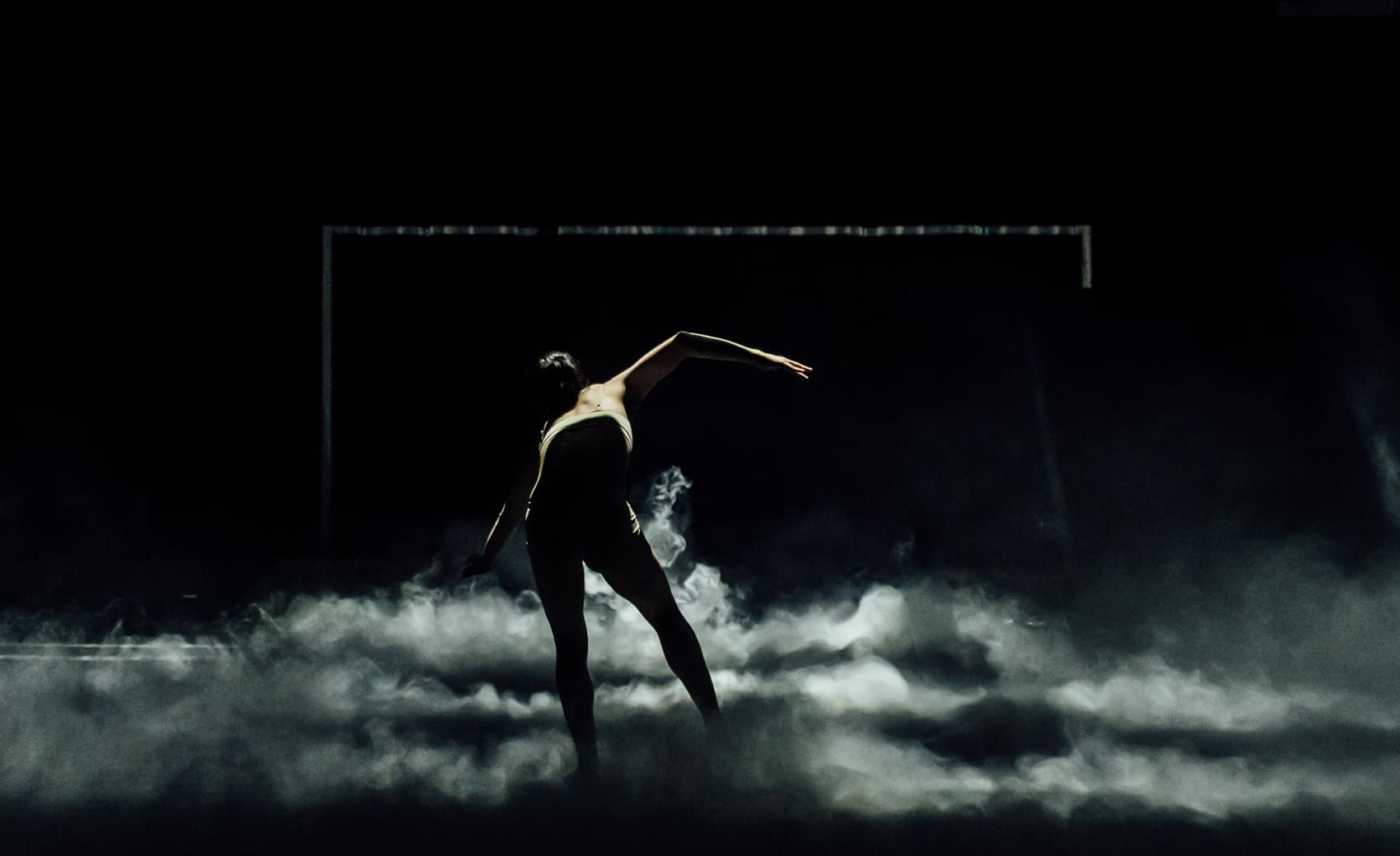舞團繼《第七感官》和《Second Body》兩部跨科技作品後的全新製作。透過結合科技形式的表現語言,延伸自《Second Body》對科技介入所帶來之身體定義改變的討論,《永恆的直線》為創作團隊探討人類在科技時代下,對於過往「肉身消逝即死亡」之定義的挑戰與想像。除再次聯手科技藝術創作團隊「叁式」和燈光設計團隊「瓦豆」,也首度與煙霧藝術家林書瑜合作,以「煙霧」飄忽不定的形態和半透明的朦朧質感,輔以劇場的燈光著色和影像投影,營造出似真似幻之景象,將觀眾帶往未知的生境,體驗一趟死生思辯的旅程。
The Eternal Straight Line is a new production after two interdisciplinary technological works, Seventh Sense and Second Body. Integrated with the expression of technology, this new work continues the discussion about the changing definition of body prompted by technological intervention in Second Body, and explores as well as challenges the idea of “death ensues when the body perishes” to re-imagine the definition of death. In addition to collaborating again with technological art studio Ultra Combos and light design team We Do Group, the dance theatre also works for the first time with cloud designer Lin Shu-Yu. Combining the indefinite form of “smoke” and its semi-transparent, blurring quality with the coloring of theatrical light and image projection, the work produces illusory, dream-like scenes, leading the audience into an unknown realm to experience a dialectic journey about death and life.
安娜琪舞蹈劇場
成立於 2010 年,舞團名稱取自 Anarchy 音譯。以當代舞蹈為主要創作形式,以肢體表現作為覺察外界的媒介,嘗試突破劇場形式,探索時間、空間、物體以及當今人與社會之間的關係。作品形式涵蓋劇場、舞蹈科技與裝置作品,包括以純舞蹈創作思考人與人的關係連結;結合科技創作深探人與科技的進退哲思。
謝杰樺/安娜琪舞蹈劇場藝術總監
在建築與舞蹈的雙重背景之下,獨特的空間概念與巧妙的科技元素,顯現出作品獨特的創作思維,為舞蹈表演和身體感官延伸出更多元的展現形式和感覺向度。跨界科技作品《第七感官》(2011) 、《Second Body》(2015)與《永恆的直線》(2019)等作品屢獲國際性指標藝術節邀演,曾為2017臺北世界大學運動會開幕典禮文化演出導演之一,也與編舞家董怡芬共同創作《日常編舞》舞蹈互動裝置系列作品,嘗試將舞蹈的展現形式延伸到『表演』以外。
Anarchy Dance Theatre
Founded in 2010, the Chinese name of the dance theatre is a phonetic translation of the English word, “anarchy.” With contemporary dance as its primary creative form, Anarchy Dance Theatre employs physical expression as a medium to perceive the external world, attempting to venture beyond the theatrical form to explore time, space, objects as well as the modern relationship between humans and society. The practice of the dance theatre blends theatre, dance technology and art installation, including pure dance choreographies that reflect on human relations as well as technology-based creations that explore philosophical thinking in the relationship between humans and technology.
HSIEH Chieh-Hua / Artistic Director of Anarchy Dance Theatre
Hsieh Chieh-Hua’s background in architecture and dance, along with his unique conceptualization of space and ingenious incorporation of technological elements, has contributed to his characteristic creative thinking, which introduces a more diversified expression and sensibility into dance performance and bodily senses. His interdisciplinary technological works include Seventh Sense (2011), Second Body (2015) and The Eternal Straight Line (2019), which have been featured in prominent international arts festivals. He was one of the directors for the opening ceremony of the 2017 Summer Universiade, and co-created the dance-installation series You Choreograph, which was done in collaboration with fellow choreographer Tung I-Fen and further pushed the boundaries of expression in dance beyond conventional “performance.”
安娜琪舞蹈劇場
謝杰樺
林家文、 PROJECT ZERO Performing Arts Management
樊香君
洪紹晴、劉俊德、甘翰馨、 田孝慈、周寬柔、Viktorija Semakaitė
叁式
曾煒傑
陳韋安
江家伶
吳克軍
顏晧真、何庭安、鄭淵升
吳克軍、吳思蔚
張存宇、許芳境 、曹家寧、呂承翰
瓦豆 We Do Group
陳大再、陳以欣
李政寬
周文明
林書瑜
黃偉、林瑜亮
澎葉生
奈鳩.布朗
邱娉勻 JUBY CHIU
鄧湘庭
戴筱凡
AxE Arts Management
李尋歡
文化部
衛武營國家藝術文化中心、 TAIWAN TOP 演藝團隊年度獎助專案
財團法人台北市客家文化基金會、 臺北市藝響空間網、新北投 71 園區、 表演 36 房永安藝文館
菁霖文化藝術基金會、安益國際集團
衛武營國家藝術文化中心 戲劇院
關鍵字
- 科技舞蹈
- 永恆的直線
- 安娜琪舞蹈劇場
- 謝杰樺
- 林書瑜
- 參式
- 瓦豆
- 數位死亡
藝術家談作品
以科技文明模糊生死界線的想像出發,結合新媒體藝術、現代舞與難以駕馭的煙霧,化現一種比擬「之間」時空的舞台氛場,透過舞影抽象,演繹物質虛實、意識有無、生死臨界。
採訪及文字整理文/吳家瑀
科技介入身體,將生命樣態解構;此番後人類世界想像,是許多科幻小說借喻反思文明的敘事場景。近年伴隨人工智慧、虛擬現實、現代醫學等科技進步,人文社會焦慮為之觸動,而科幻文學為科技可能擘劃的未來預作提問、為我們提供審視人與科技關係的視野,其中一個核心命題,莫過於辯證生死、探問存在本質——意即,若肉身有無已不足界定生死,意識可被上傳雲端,或是仿生超越真身,何以是生命徵象和死亡定義?人之為人的本質與價值,又會是甚麼?又或者,是否仍有追問之必要?
科技身體,存在之思
2019年舞作《永恆的直線》,以科技文明模糊生死界線的想像出發,結合新媒體藝術、現代舞與難以駕馭的煙霧,化現一種比擬「之間」時空的舞台氛場,透過舞影抽象,演繹物質虛實、意識有無、生死臨界。
舞創起點,來自於編舞家謝杰樺感悟年紀漸長,面對死亡課題之日愈發迫近。回看舞團創立之初,2011年首部作品《第七感官》獲文建會計畫補助,開啟科技與舞蹈跨界合作契機,續作《Second Body》探討科技如何改變身體控制及其意象。因此,本次便延續思考科技與身體之軸線,轉向形而上領域,尋思科技改變死亡定義以後的存在之境。
生死之間,縹緲涵納萬千
雖談生死過渡、無有曖昧,謝杰樺並未指定舞作場景的空間脈絡。佛教說的「中陰」是構想初期參考概念,但各學科對於生死意識轉換及其居間性質,各有詮釋。因此,謝杰樺更願在連通生死兩界的情境視野之外,涵納諸般界於兩點之間的形體、概念和感知維度。「這個作品,整體意象就是一個存在與不存在、見與不見的中間狀態⋯⋯所以希望透過一種超越,去表達那個還沒到過的地方。」
尋覓視覺所似,謝杰樺表示,煙霧飄忽輕渺,隨光影變化若隱若現,做為此次題材意象和營造空間的介質,再適合不過。正巧他得知新媒體藝術家林書瑜擁有劇場操控煙霧的實務背景,遂邀請他加入團隊。一連串的挑戰於是開始,謝杰樺說,煙霧的形狀和運動難以掌握,本身溫度濃度都會影響成果。另則,熟悉環境條件是基本功,空間風動、環境溫濕,甚至觀眾體溫,也是左右實驗結果的參數暨變數。可偏偏場地狀態與時俱變,使團隊屢敗屢戰,總掙扎於捉摸未知的無力感。幸而光影塵霧,最終於正式演出如願呈現,不枉過程坎坷。
與煙共舞,朝向科技異境
「煙霧也是表演者。舞者不斷與煙共舞,最後會有一種心電感應的狀態。」謝杰樺說,舞者體溫和動作擾動渦流,都會打散煙霧畫面,使效果不如預期。最初舞者沒有煙霧為伴,只能憑空想像與煙互動,或接收指令,以身體模擬煙霧形態。直到實際排練,舞者本於過去在《第七感官》配合互動科技調整動作的經驗,更懂得細緻微調肢體,與煙共存,合跳雙人舞步。
「舞蹈之美,就在於它可以不那麼具象,而只是去表達一種狀態。」部分段落加入送行往生者的意義動作,隱約鋪陳聯想。然整體而言,作品更訴求感官沉浸於環場,被舞動所欲傳達的指涉意象包覆,進入影像投影和音樂聲響營造與推進的數位情境,身心更加朝向舞作原名,「恍似生境的他方」。
若說當今各領域對於科技介入身體的反饋與懸念,也是人與科技交涉進程中必然經歷的過渡,創作的外延,謝杰樺也不忘觸及更廣泛的思考。對他來說,《永恆的直線》呈現的「科技介入身體」與「中間狀態」,不單止於探問生命有無的真義,就表演藝術來說,還包括本作起用的劇場技術,以及對工作模式因應技術而改變、舞者配合科技應用而調整動作等種種適應。是以,在科技滲透生活的今日,對身處的當下世界有所體察覺知,或當也是本作額外給出的訊息。
評審談作品
本作一方面藉著引靈台灣俗民文化中的生死觀基底,將「作為世界中的身體」此一舞蹈命題實踐了新詮,更成功借喻意念與想像超越死生界限之可能。
作品由生命的終結做為開端,儀式性的場景揭示了死生一事是本作的基礎提問。編舞謝杰樺大膽地透過虛擬往生者中陰身的視野「體驗」,建構了瑰麗詭異的旅途情境,「再現」了連通生、死兩界之間從無生者能以身往還的甬道。途徑中有著「彼岸花」喻意的「赤團華」,最終再以設計精準的煙霧與光束將觀眾包含入內的造境,巧妙地將「彼岸」/「死後的終點」具現於觀眾集體第一人稱的體驗與想像交疊之中。本作一方面藉著引靈台灣俗民文化中的生死觀基底,將「作為世界中的身體」此一舞蹈命題實踐了新詮,更成功借喻意念與想像超越死生界限之可能。 (主筆/林育世)
This work begins with the end of life, unveiling its fundamental questioning about death and life with ritualistic scenes. The choreographer Hsieh Chieh-Hua boldly constructs an eerily splendid journey with the visual “experience” of a bardo belonging to a virtual dead and “represents” the path that connects the world of the living and the dead, through which the lifeless can physically travel through. Along the path are “stonegarlics” that symbolize the “manjusaka.” Finally, smoke and laser beams are used with precision to create an immersive realm for the audience, ingeniously embodying and overlapping “the other shore/the end in the afterlife” with the audience’s collective and first-person experience. Based on the concept of life and death in the Taiwanese folk culture of guiding the soul, this work gives a new interpretation to the dance topic of “the body in the world” while serving as a successful metaphor for achieving the possibility of transcending the boundary of life and death through the mind and imagination. (Commentator: LIN Yu-Shih)




.jpg)



